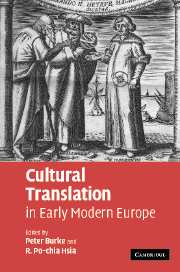Book contents
- Frontmatter
- Contents
- Notes on contributors
- Introduction
- PART I TRANSLATION AND LANGUAGE
- 1 Cultures of translation in early modern Europe
- 2 The Catholic mission and translations in China, 1583–1700
- 3 Language as a means of transfer of cultural values
- 4 Translations into Latin in early modern Europe
- PART II TRANSLATION AND CULTURE
- PART III TRANSLATION AND SCIENCE
- Bibliography
- Index
2 - The Catholic mission and translations in China, 1583–1700
Published online by Cambridge University Press: 27 July 2009
- Frontmatter
- Contents
- Notes on contributors
- Introduction
- PART I TRANSLATION AND LANGUAGE
- 1 Cultures of translation in early modern Europe
- 2 The Catholic mission and translations in China, 1583–1700
- 3 Language as a means of transfer of cultural values
- 4 Translations into Latin in early modern Europe
- PART II TRANSLATION AND CULTURE
- PART III TRANSLATION AND SCIENCE
- Bibliography
- Index
Summary
Between the establishment of the Catholic mission in China by the two Italian Jesuits Michele Ruggieri and Matteo Ricci in 1583 and the apex of its success around the year 1700, European missionaries composed and published c. 450 works in Chinese. Of this total, some 120 texts deal with European science, technology and geography; another 330 are religious texts. This chapter will investigate the role of translations in this Sino-European cultural exchange: What texts were translated? Who were the translators? What were the different processes of translation? And what impact did translations exert in the cultural reception of Europe in early modern China?
Our first task, to determine the exact number of translations, involves some explanation. It can be established that of the 450 texts, at least 50 are translations in the modern sense, i.e. the adaptation of a text in whole or in parts from one language into another. There is, for example, the 1607 translation of Euclid's Elementa, undertaken jointly by Matteo Ricci and Paul Xu Guangqi, or the partial translation of Thomas Aquinas's Summa theologica by Ludovico Buglio SJ, completed between 1654 and 1678.
There were other methods of rendering European texts into Chinese that did not follow exact translations. European missionaries presented titles that paraphrased, compiled and summarized the original texts, taking account of which would substantially expand the body of translated works. In other words, in addition to translation in the strict sense, there were two further methods of textual transmission.
- Type
- Chapter
- Information
- Cultural Translation in Early Modern Europe , pp. 39 - 51Publisher: Cambridge University PressPrint publication year: 2007
- 13
- Cited by

